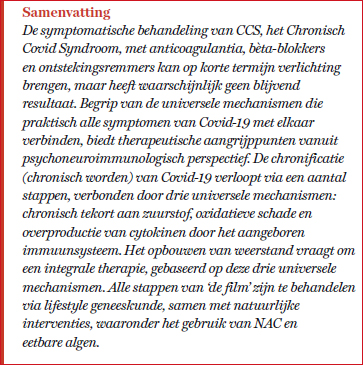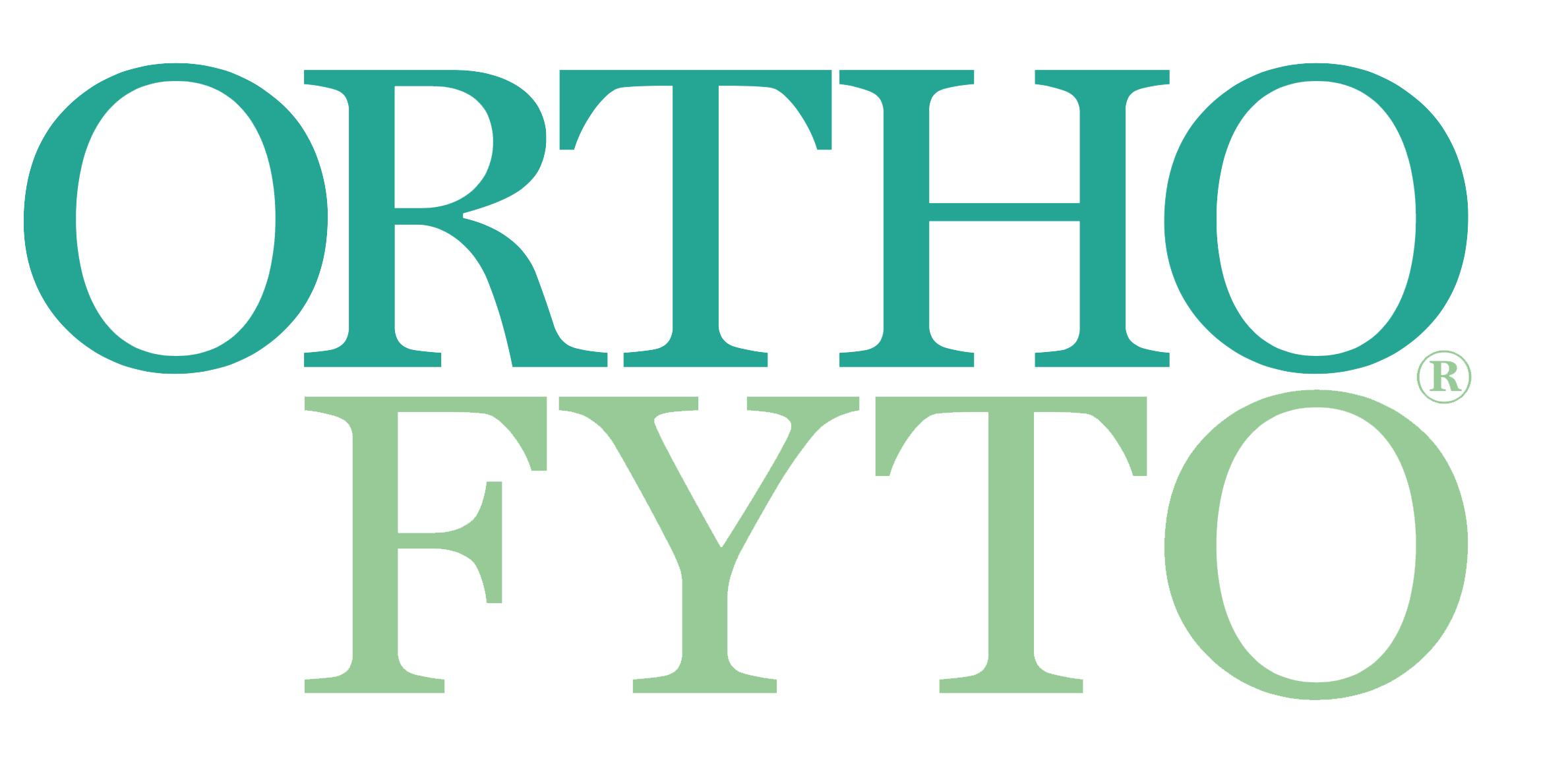Covid-19: van de foto naar de film
25 May, 2021
Door: Leo Pruimboom

Symptomatische interventies zijn meestal slechts anti-inflammatoir maar leiden niet tot de oplossing. ‘Filmgeneeskunde’ geeft de mogelijkheid om niet alleen de oorzaken van en de gevoeligheid voor een bepaald ziektebeeld in kaart te brengen, het maakt ook de ontwikkeling mogelijk van interventies gebaseerd op de werkingsmechanismen die uiteindelijk leiden tot dat ziektebeeld. De foto’s of stills zijn de losse inzichten; samen vormen ze de film die het verband en verloop laat zien.
De door SARS-CoV-2 veroorzaakte pandemie had eind april ruim 149.217.000 mensen besmet en meer dan drie miljoen mensen zijn eraan overleden.1 Terwijl de wetenschappelijke en politieke werelden zich nog steeds intensief bezighouden met het voorkomen van verdere infecties, zieken en doden, wordt een nieuw fenomeen al zichtbaar: het post-acute en chronische-Covid-19-syndroom. Epidemiologische data van mensen die lijden aan het postvirale syndroom variëren van 20% tot 87%2, afhankelijk van het moment van meten en de inclusiecriteria voor de diagnose.3
De oorzaken die worden beschreven voor de ontwikkeling van het postvirale syndroom verlopen van virale persistentie, via residuale virale en immunologische schade tot en met iatrogene interventies. Therapieën zijn vooral gericht op symptoombehandeling en behelzen het gebruik van anticoagulantia, bètablokkers en ontstekingsremmers.4 Op korte termijn kan dat verlichting geven maar het heeft waarschijnlijk geen blijvend resultaat, gezien de ervaringen met SARS-CoV-1 en MERS.5
Lees het gehele artikel vanaf pagina 34 in OrthoFyto 3/21.
Wilt u het gehele artikel als PDF bestand ontvangen? Bestel het dan hier voor € 3,50.
Bronvermelding:
1. World Health Organisation. Coronavirus. Geraadpleegd op 29 april 2021 via www.who.int/health-topics/coronavirus#tab=tab_1
2. Nalbandian, A., Sehgal, K., Gupta, A., Madhavan, M. V., McGroder, C., Stevens, J. S., Cook, J. R., Nordvig, A. S., Shalev, D., Sehrawat, T. S., Ahluwalia, N., Bikdeli, B., Dietz, D., Der-Nigoghossian, C., Liyanage-Don, N., Rosner, G. F., Bernstein, E. J., Mohan, S., Beckley, A. A., … Wan, E. Y. (2021). Post-acute COVID-19 syndrome. Nature Medicine.
3. Cortinovis, M., Perico, N., & Remuzzi, G. (2021). Long-term follow-up of recovered patients with COVID-19. The Lancet, 397(10270), 173–175. https://doi.org/10.1016/S0140-6736(21)00039-8.
4. Huang, C., Huang, L., Wang, Y., Li, X., Ren, L., Gu, X., Kang, L., Guo, L., Liu, M., Zhou, X., Luo, J., Huang, Z., Tu, S., Zhao, Y., Chen, L., Xu, D., Li, Y., Li, C., Peng, L., … Cao, B. (2021). 6-month consequences of COVID-19 in patients discharged from hospital: a cohort study. The Lancet, 397(10270), 220–232.
5. O’Sullivan, O. (2021). Long-term sequelae following previous coronavirus epidemics. Clinical Medicine, Journal of the Royal College of Physicians of London, 21(1), E68–E70.
6. Nunn, A. V. W., Guy, G. W., Brysch, W., Botchway, S. W., Frasch, W., Calabrese, E. J., & Bell, J. D. (2020). SARS-CoV-2 and mitochondrial health: implications of lifestyle and ageing. Immunity and Ageing, 17 (1), 1–21.
7. Melchinger, H., Jain, K., Tyagi, T., & Hwa, J. (2019). Role of Platelet Mitochondria: Life in a Nucleus-Free Zone. Frontiers in Cardiovascular Medicine, 6 (October), 1–11.
8. Lee, J. H., Park, A., Oh, K. J., Lee, S. C., Kim, W. K., & Bae, K. H. (2019). The role of adipose tissue mitochondria: Regulation of mitochondrial function for the treatment of metabolic diseases. International Journal of Molecular Sciences, 20(19).
9. Pasquarelli-do-Nascimento, G., Braz-de-Melo, H. A., Faria, S. S., Santos, I. de O., Kobinger, G. P., & Magalhães, K. G. (2020). Hypercoagulopathy and Adipose Tissue Exacerbated Inflammation May Explain Higher Mortality in COVID-19 Patients With Obesity. Frontiers in Endocrinology, 11(July), 1–16.
10. Zhang, S., Liu, Y., Wang, X., Yang, L., Li, H., Wang, Y., Liu, M., Zhao, X., Xie, Y., Yang, Y., Zhang, S., Fan, Z., Dong, J., Yuan, Z., Ding, Z., Zhang, Y., & Hu, L. (2020). SARS-CoV-2 binds platelet ACE2 to enhance thrombosis in COVID-19. Journal of Hematology and Oncology, 13(1), 1–22. https://doi.org/10.1186/s13045-020-00954-7.
11. Caniglia JL, Guda MR, Asuthkar S, Tsung AJ, Velpula KK. 2020. A potential role for Galectin-3 inhibitors in the treatment of COVID-19. PeerJ 8:e9392 https://doi.org/10.7717/peerj.9392
12. Bulai, T., Bratosin, D., Pons, A., Montreuil, J., & Zanetta, J. P. (2003). Diversity of the human erythrocyte membrane sialic acids in relation with blood groups. FEBS Letters, 534(1–3), 185–189.
13. Pruimboom, L. (2021). SARS-CoV 2; Possible alternative virus receptors and pathophysiological determinants. Medical Hypotheses, 146(xxxx), 110368.
14. Baker, A. N., Richards, S. J., Guy, C. S., Congdon, T. R., Hasan, M., Zwetsloot, A. J., Gallo, A., Lewandowski, J. R., Stansfeld, P. J., Straube, A., Walker, M., Chessa, S., Pergolizzi, G., Dedola, S., Field, R. A., & Gibson, M. I. (2020). The SARS-COV-2 Spike Protein Binds Sialic Acids and Enables Rapid Detection in a Lateral Flow Point of Care Diagnostic Device. ACS Central Science, 6(11), 2046–2052.
15. Lunt SY, Vander Heiden MG. Aerobic glycolysis: meeting the metabolic requirements of cell proliferation. Annu Rev Cell Dev Biol. 2011;27:441-64.
16. Reva, I., Yamamoto, T., Rasskazova, M., Lemeshko, T., Usov, V., Krasnikov, Y., Fisenko, A., Kotsyurbiy, E., Tudakov, V., Tsegolnik, E., Oleksenko, O., Korobkin, A., Slabenko, E., Shindina, A., Gordzievskaya, K., Furgal, A., & Reva, G. (2020). Erythrocytes As a Target of Sars Cov-2 in Pathogenesis of Covid-19. Archiv Euromedica, 10(3), 5–11.
17. Silverio, R., Gonçalves, D. C., Andrade, M. F., & Seelaender, M. (2020). Coronavirus Disease 2019 (COVID-19) and Nutritional Status: The Missing Link? Advances in Nutrition, 2019, 1–11.
18. Rogers, J. P., & David, A. S. (2021). A longer look at COVID-19 and neuropsychiatric outcomes. The Lancet Psychiatry, 8(5), 351–352.
19. Taquet, M., Geddes, J. R., Husain, M., Luciano, S., & Harrison, P. J. (2021). 6-month neurological and psychiatric outcomes in 236 379 survivors of COVID-19: a retrospective cohort study using electronic health records. The Lancet Psychiatry, 8(5), 416–427.
20. Quigley, E. M. M., Pot, B., & Sanders, M. E. (2018). ‘Brain Fogginess’ and D-Lactic Acidosis: Probiotics Are Not the Cause. Clinical and Translational Gastroenterology, 9(9), 0–1.
21. Monroe, G. R., van Eerde, A. M., Tessadori, F., Duran, K. J., Savelberg, S. M. C., van Alfen, J. C., Terhal, P. A., van der Crabben, S. N., Lichtenbelt, K. D., Fuchs, S. A., Gerrits, J., van Roosmalen, M. J., van Gassen, K. L., van Aalderen, M., Koot, B. G., Oostendorp, M., Duran, M., Visser, G., de Koning, T. J., … Jans, J. J. (2019). Identification of human D lactate dehydrogenase deficiency. Nature Communications, 10(1).
22. Dhar D, Mohanty A. Gut microbiota and Covid-19- possible link and implications. Virus Res. 2020 Aug;285:198018.. Epub 2020 May 13.
23. Kim, H. S. (2021). Do an altered gut microbiota and an associated leaky gut affect COVID-19 severity? MBio, 12(1), 1–9.
24. Gentile, S., Strollo, F., Mambro, A., & Ceriello, A. (2020). COVID-19, ketoacidosis and new-onset diabetes: Are there possible cause and effect relationships among them? Diabetes, Obesity and Metabolism, 22(12), 2507–2508.
25. Fignani, D., Licata, G., Brusco, N., Nigi, L., Grieco, G. E., Marselli, L., Overbergh, L., Gysemans, C., Colli, M. L., Marchetti, P., Mathieu, C., Eizirik, D. L., Sebastiani, G., & Dotta, F. (2020). SARS-CoV-2 Receptor Angiotensin I-Converting Enzyme Type 2 (ACE2) Is Expressed in Human Pancreatic β-Cells and in the Human Pancreas Microvasculature. Frontiers in Endocrinology, 11(November), 1–19.
26. Mater, Y., & Beyhan-Ozdas, S. (2019). The analysis of surface saccharide profiles through fluorescein-labelled lectins in a rat pancreatic tissue with established metabolic syndrome model. Turkish Journal of Biochemistry, 44(1), 98–104.
27. Engin AB, Engin ED, Engin A. Dual function of sialic acid in gastrointestinal SARS-CoV-2 infection. Environ Toxicol Pharmacol. 2020;79:103436.
28. Casalino L, Gaieb Z, GoldsmithJ, Hjorth C et al. Beyond Shielding: The Roles of Glycans in the SARS-CoV-2 Spike Protein. ACS Central Science 2020 6 (10), 1722-1734.
29. Akif, F. (2020). Lectin Therapy: A Way to Explore in Order to Inhibit the Binding of COVID-19 to these Host Cells. International Journal of Innovative Science and Research Technology, 5(5), 1280–1286.
30. Barre, A.; Damme, E.J.M.V.; Simplicien, M.; Benoist, H.; Rougé, P. Man-Specific, GalNAc/T/Tn-Specific and Neu5Ac-Specific Seaweed Lectins as Glycan Probes for the SARS-CoV-2 (COVID-19). Coronavirus. Mar. Drugs 2020, 18, 543.
31. Zoretić, D., Grčić-Zubčević, N., & Zubčić, K. (2014). The effects of hypercapnic-hypoxic training program on hemoglobin concentration and maximum oxygen uptake of elite swimmers. Kinesiology : International Journal of Fundamental and Applied Kinesiology, 46(Supplement 1), 40–45.
32. Karaula, D, Homolak, J, & Leko, G. (2016). Effects of hypercapnic-hypoxic training on respiratory muscle strength and front crawl stroke performance among elite swimmers. Turkish Journal of Sport and Exercise, 18(1), 17.
33. Buijze, G. A., Sierevelt, I. N., Van Der Heijden, B. C. J. M., Dijkgraaf, M. G., & Frings-Dresen, M. H. W. (2016). The effect of cold showering on health and work: A randomized controlled trial. PLoS ONE, 11(9), 1–15.
34. Liikkanen, L. A., & Laukkanen, J. A. (2021). Sauna bathing frequency in Finland and the impact of COVID-19. Complementary Therapies in Medicine, 56(October 2020), 14–17.
35. Adebola Okunola E, O. (2021). Overview of the Rationale for L-Glutamine Treatment in Moderate-Severe COVID-19 Infection. Journal of Infectious Diseases and Epidemiology, 7(1), 1–7.
36. Bourgonje, A. R., Offringa, A. K., van Eijk, L. E., Abdulle, A. E., Hillebrands, J.-L., van der Voort, P. H. J., van Goor, H., & van Hezik, E. J. (2021). N-Acetylcysteine and Hydrogen Sulfide in Coronavirus Disease 2019. Antioxidants & Redox Signaling, 00(00), 1–19.
